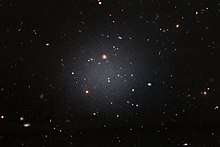NGC 1052-DF2
| NGC 1052-DF2 | |
|---|---|
 Observations of NGC 1052-DF2 show lack of dark matter.[1] | |
| Observation data | |
| Constellation | Cetus |
| Right ascension | 02h 41m 46.8s[2] |
| Declination | −08° 24′ 12″[2] |
| Distance (comoving) | 19.0 ± 1.7 Mpc (62.0 ± 5.5 Mly)[2] |
| Characteristics | |
| Type | Sp...[3] |
| Mass | 2×108[2] M☉ |
| Apparent size (V) | 1.20′ × 1.12′[3] |
| Other designations | |
| PGC 3097693[3] | |
NGC 1052-DF2 is an ultra diffuse galaxy in the constellation Cetus. It has been proposed that it contains little or no dark matter, the first such discovery, although follow-up studies have not confirmed this. The distance to the galaxy, derived by surface brightness fluctuation, is 19 1.7 Mpc. Due to close proximity, it is assumed to be associated with the elliptical galaxy NGC 1052 and to lie at a distance of about 20 Mpc.
The apparent lack of dark matter in NGC 1052-DF2 may help prove that dark matter is real: if what appears to be dark matter is really just a currently unknown effect of the gravity of ordinary matter then this apparent dark matter should also appear in this galaxy. Further study will be needed before this and any other possible implications can be confirmed.[4][5] If confirmed, the absence of dark matter may also have implications for theories of galaxy formation, as dark matter has been thought to be needed for galaxy formation.[5]
Later studies have failed to confirm the lack of dark matter, and shown only that it is likely to have a mass-to-light ratio towards the low end of expected values for a dwarf galaxy.[6]
See also
- Abell 520
- Bullet cluster
- Dragonfly 44--a galaxy thought to be almost all dark matter.
References
- ↑ "Hubble finds first galaxy in the local Universe without dark matter". www.spacetelescope.org. Retrieved 30 March 2018.
- 1 2 3 4 Van Dokkum, Pieter; Danieli, Shany; Cohen, Yotam; Merritt, Allison; Romanowsky, Aaron J; Abraham, Roberto; Brodie, Jean; Conroy, Charlie; Lokhorst, Deborah; Mowla, Lamiya; o'Sullivan, Ewan; Zhang, Jielai (2018). "A galaxy lacking dark matter". Nature. 555 (7698): 629. arXiv:1803.10237. Bibcode:2018Natur.555..629V. doi:10.1038/nature25767. PMID 29595770.
- 1 2 3 "LEDA 3097693". SIMBAD. Centre de données astronomiques de Strasbourg. Retrieved 15 April 2018.
- ↑ Mary Halton, Science reporter (28 March 2018). "Ghostly galaxy may be missing dark matter". BBC News. Retrieved 29 March 2018.
For Mack, the most exciting aspect of this galaxy is its potential to prove that dark matter - until now widely theorised but not directly observed - is real. If dark matter were just an unexplained effect of the gravity from regular matter, its effects would be visible in this galaxy. ... More work remains to be done on this and similar objects before dark matter theory needs to be fundamentally altered, however.
- 1 2 "Dark Matter Goes Missing in Oddball Galaxy". NASA. 28 March 2018. Retrieved 2 April 2018.
We thought that every galaxy had dark matter and that dark matter is how a galaxy begins," said Pieter van Dokkum of Yale University in New Haven, Connecticut, lead researcher of the Hubble observations. "This invisible, mysterious substance is the most dominant aspect of any galaxy. So finding a galaxy without it is unexpected. It challenges the standard ideas of how we think galaxies work, and it shows that dark matter is real: it has its own separate existence apart from other components of galaxies. This result also suggests that there may be more than one way to form a galaxy.
- ↑ Martin, Nicolas F; Collins, Michelle L. M; Longeard, Nicolas; Tollerud, Erik (2018). "Current Velocity Data on Dwarf Galaxy NGC 1052-DF2 do not Constrain it to Lack Dark Matter". The Astrophysical Journal. 859: L5. arXiv:1804.04136. Bibcode:2018ApJ...859L...5M. doi:10.3847/2041-8213/aac216.